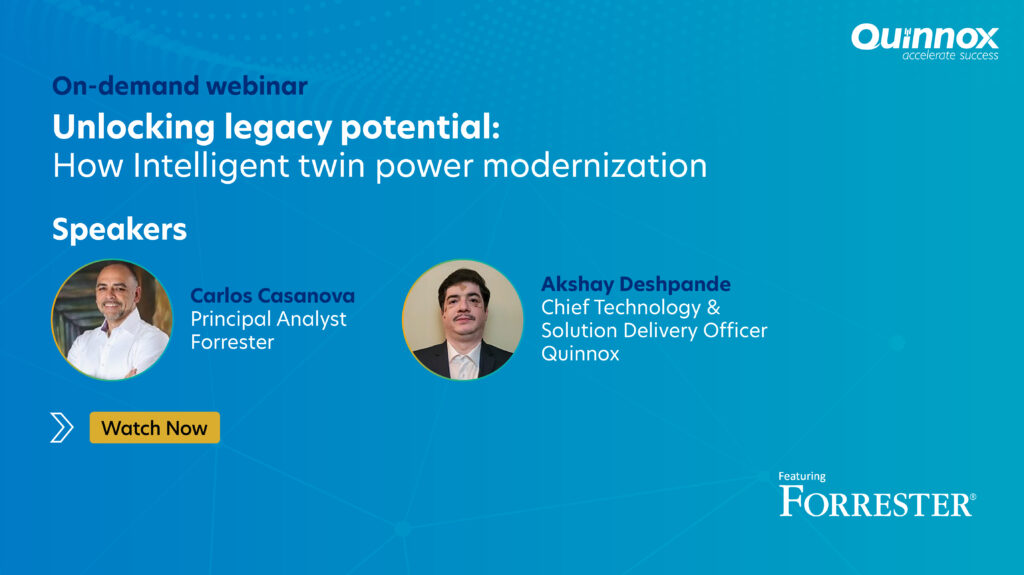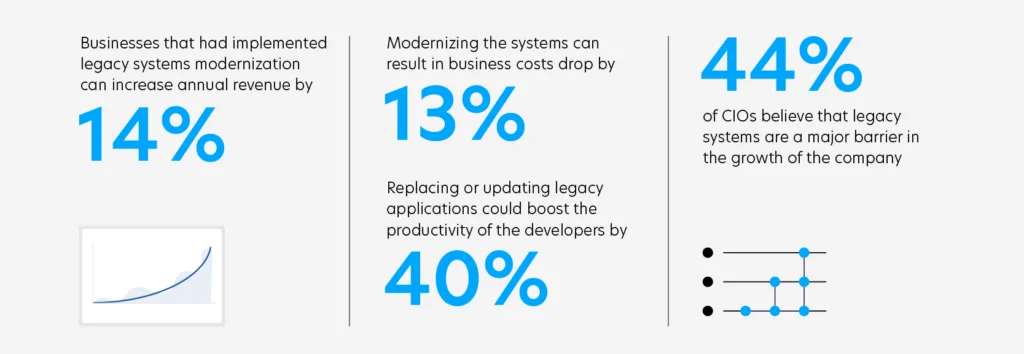IT has been around for ages, and both hardware and software have significantly changed since then. Many embraced newer technologies and moved, while others remained stuck in various legacy technologies as legacy changed its definition over time.
I remember when I started my career, mainframes used to be called legacy back then, which is still thriving, but now even technology as old as ten years are coined as legacy technology which continues to be the backbone of many organizations, providing stability and critical functionality over years. However, at the same time, rapidly evolving technological landscape, changing user personas and needs are pushing organizations to upgrade their technology which has made legacy modernization more apparent now than ever.
Legacy systems, often built on older (unsupported) technologies, can hinder innovation and scalability, leading to:
- Compliance issues: As reported by KPMG in 2023, 72% of organizations struggle with compliance due to legacy systems.
- Reduced employee productivity: McKinsey’s 2023 research revealed that legacy systems add 20-30% more time to tasks, hampering overall productivity.
- Lost customers: As indicated by Microsoft’s 2023 study, a striking 91% of customers cease doing business with companies hindered by outdated technology.
The need to keep up with this pace of change has become a defining factor for business success. Sticking to legacy systems in such a dynamic environment can lead to significant disadvantages. Legacy systems, while once reliable and effective, are now often unable to meet the evolving demands of modern businesses and consumers. They might lack compatibility with newer technologies, exhibit security vulnerabilities, and hamper the agility needed to respond to market shifts.
Watch Forrester Webinar on AIOps & Intelligent Twin Power
Watch this on-demand webinar to get expert insights and strategies from Forrester analyst on how to navigate the complexities of modernization and harness the power of AIOPs for transformative business outcomes

Why Modernize Legacy Systems?
Embracing modern technologies like cloud computing, microservices architecture, AI, and advanced analytics becomes imperative to a future-proof reference architecture of an organization, minimizing any technical debt and keeping the technology landscape more composable.

Legacy modernization offers a strategic pathway for businesses to shed the constraints of outdated systems and embrace the advantages of modern technology. The key benefits of Legacy Modernization are as follows:
Enhanced Agility: Modernizing legacy systems enables organizations to respond quickly to market changes, adapt to new technologies, and stay ahead of the competition.
Operational Efficiency: Upgrading older systems often reduces maintenance costs and increases operational efficiency, freeing up resources for strategic initiatives.
Improved Customer Experience: Legacy modernization allows for the integration of user-friendly interfaces and keeping the user journeys simple, enhancing the overall customer experience and satisfaction.
Scalability: Modernized systems can easily scale to accommodate growing business needs, providing a foundation for future growth.
While the benefits sound exciting, legacy modernization is not as simple as it sounds and needs proper consideration of key architectural principles. The main challenges to look out for in Legacy Modernization are as follows:
Legacy Code Complexity: Untangling intricate legacy code can be challenging, requiring careful planning and skilled development teams.
Data Migration Risks: Migrating data from legacy systems to modern platforms involves risks such as data loss and integrity issues.
Resistance to Change: Employees and stakeholders may resist the transition due to familiarity with existing systems, emphasizing the importance of change management strategies.
Downtime Concerns: The fear of business disruptions during the modernization process can be a significant hurdle. Effective planning and phased approaches are crucial to mitigate downtime risks.
Mastering the Art: Quinnox's Legacy Modernization Best Practices
Quinnox has mastered this art over the last three decades and has been the front-runner of legacy modernization within its client base, with several IPs and assets enabling smooth, successful, and accelerated modernization. A few best practices for a successful modernization exercise that Quinnox follows:
Comprehensive Assessment: Conducting a thorough analysis of existing systems to identify weaknesses, dependencies, and areas for improvement.
Phased Approach: Implementing a phased modernization strategy to minimize risks and disruptions, ensuring a smooth transition.
Collaboration and Communication: Fostering open communication between IT teams, stakeholders, and end-users to address concerns and promote a shared vision for modernization, along with co-owning risks and benefits.
Final Thoughts
Legacy modernization is not just a necessity; it is a strategic investment in the future. By addressing the challenges head-on and embracing the benefits of modern technologies, organizations can transform their operations, enhance customer experiences, and position themselves as leaders in an ever-evolving digital landscape. The journey may be complex, but the rewards of a modernized legacy system are well worth the effort.
As the business landscape continues to evolve, the time to embrace change, unlearn legacy practices, and leverage new technology is now. Only by doing so can organizations redefine innovation, out-innovate their peers, and secure their competitive edge in a rapidly evolving marketplace.
To delve deeper into the critical significance of legacy modernization and the pivotal role of AI in driving modernization efforts, we invite you to register now for our upcoming webinar featuring Principal Analyst from Forrester, Carlos Casanova, and Akshay Deshpande, Chief Technology & Solution Delivery Officer Corporate at Quinnox. Gain invaluable insights into the strategies and best practices that will empower your organization to thrive amidst the ever-evolving technological landscape.
Register today to avail a personalized complimentary Forrester expert-led Advisory session! For details, check here: https://www.quinnox.com/complimentary-forrester-advisory-session/
